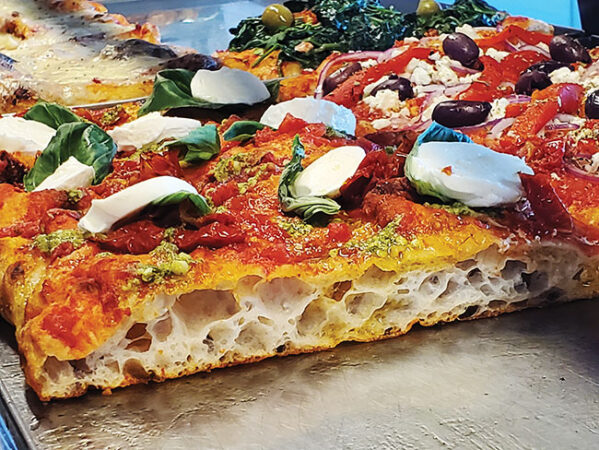
The Pizza Chef: Single bake versus double bake
Diana Cline
Features Business and Operations In the Kitchen Recipes Techniques Trends crust pizza styles If you can, always allow your pan and dough to warm up at least 25 minutes before baking.
Photo: Redi Pizza, Montreal
If you can, always allow your pan and dough to warm up at least 25 minutes before baking.
Photo: Redi Pizza, Montreal Most fresh pizzas are cooked with a single-bake method, meaning the raw pizza dough is stretched out, or pressed out into a pan, sauced, cheesed and topped then fully baked at 450 F or hotter. The dough is baked alongside of the toppings and the cheese is melted and browned.
But there are some types of pizzas where a double bake, or parbake, is necessary. This method is where the raw dough is stretched out, and/or pressed into a pan, then docked, and baked on its own, until it’s essentially a fully baked pizza crust. Some pizza franchises choose to use this style of pizza crust for ease of operations with a centralized commissary. One big reason is that you eliminate the raw pizza dough component and its challenges in handling, shelf life and delivery to your stores. Several franchises offer a deep-dish style pan pizza, and they use a parbaked thick-crust pizza shell as the base for that option.
There are many reasons why one would choose to double bake a pizza: Detroit-style pizzas are typically made this way, because the amount of raw dough in the pan needs its own time to fully bake. This allows the crust to fully form into its mostly finished state before adding the sauce, cheeses and toppings. By parbaking the crust ahead, the cooking time for finishing the pizzas is reduced: a thick-crust pan pizza, made with raw dough might take 45 minutes to fully cook, but by using a parbaked crust, that bake time is eight to 15 minutes, depending on your temperature and the amount of cheese and toppings. Some high-hydration pizza dough recipes are by nature automatically panned, because they are too difficult to hand stretch: they literally stick to everything, and the more they are handled the tougher the crust becomes. These high-hydration recipes are often twice baked, so that the cell structure of the crust is fully formed and isn’t compromised by the heaviness of the sauce and cheeses.
It’s the same idea for flatbreads and extra-thin pizzas. When you parbake the pizza dough into a shell, you’ve significantly reduced final cook times. At Diana’s, we do this with our flatbreads, and Crispy Thin Crust, not only to reduce final cook times, but also because we love the extra crispness twice-baked flatbread produces.
The other advantage of having a double-baked crust is that it eliminates the dreaded gum line. All fresh, single-baked pizzas will have a gum line – it’s the layer of raw, uncooked dough between the cooked crust and the sauce – but some fresh, single-baked pizzas have an overpronounced gum line, which makes the pizza unpalatable. With a double-baked or parbaked crust, there is no raw dough left to create this gummy texture: it’s all baked out. For tips on reducing the gum line on single-baked pizzas, check out my article “Reducing the Gum Line.”
I know of a couple of wood-fired oven pizzerias that have periods of customer peaks that are so busy they have difficulty keeping their oven at the top 900 F temperature. If you’ve ever worked with this kind of oven, you know that if you can’t give the oven time to recover, your bake times drop significantly, and if you’re not careful, you can send out undercooked pizzas. For the sake of consistency and ease of operations, these wood-fired pizzerias parbake their crusts in the early afternoon. That way, during the peak times, they can still bang out pizzas in short time.
If you’re doing a pan-style pizza in a stone-floor oven and putting that pan of raw dough in the oven straight from the cooler, you’re going to pull a ton of heat out from your oven stone. It’s going to take even longer to bake that pizza, and it will require longer recovery time for that spot in your oven. It’s another reason many choose to double bake a pan-style pizza, and to parbake the crust at an earlier non-peak time. Whether you choose to single or double bake all or only some of your pizzas, consider the style of pizza you’re offering and the consistency you need in the kitchen during peak times to do it well. | CP
Diana Cline is an award-winning pizza chef, a partner with Diana’s Cucina & Lounge in Winnipeg. In addition to creating award-winning recipes, Diana is a consultant to other pizzeria owner/operators in menu development, creating operational systems and marketing to help operators grow their business strategically. Contact her at diana@dianascucinaandlounge.com.
Print this page